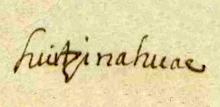Huitznahuac (T2781:11:511r)
This late-sixteenth-century place glyph is for the toponym Huitznahuac ("Near the Thorns"). It consists of two elements, a more or less traditional rendition of a hill (tepetl)] topped with a glyph for a thorn (huitztli). The glyph originally appeared upside-down in relation to the gloss identifying it (see the historical contextualizing image and gloss). The hill is colored in green with a red band at its base with curled ends. It also has three light brown rocky outcroppings, one on the top and one on each side of the hill’s slopes. The glyph on the summit of the hill supports the black-outlined thorn, with barbs facing to the left. There is no visualization of the -nahuac element (next to, on the side of, near; close to; with, in company of) that might be expected to be present in some way, possibly a function of the relatively late creation of the glyph and the manuscript upon which it appears, a time when the intricacies of glyphic writing might have been fading. Instead, the alphabetic gloss provides the locative suffix.
Robert Haskett
The place glyph for Huitznahuac appears among a cluster of other images of tepetl on the lower left side of the manuscript (see the historical contextualizing image). The pictorial was created sometime around 1590 and is included among the folios of an investigation into a request by Luis de Sandoval for a grant of a sitio de estancia de ganado menor (ranch for small livestock) and six caballerías of land located near the cerro (hill) of Hutiznahuac, which is within the limits of the municipality of Cempohuallan (today, Zempoala, Hidalgo). A Spanish-language gloss to the left of the place glyph states, “huitznahuac donde se pide el sitio de ti[erra]” (Huitznahuac, where the landsite is being requested). The requested sites are also in the vicinity of the pueblos of Tlaquilpan and San Antonio de Octoyuca. This pictorial manuscript is discussed in Pulido Rull, Ana, Mapping Indigenous Land: Native Land Grants in Colonial New Spain (Norman: University of Oklahoma Press, 2020). An image of the manuscript is found as Plate 4 in the book.
John Bierhorst (A Nahuatl-English Dictionary and Concordance to the Cantares Mexicanos, 1985, 143) says that Huitznahuatl was a "name or epithet of a god to whom slaves were sacrificed in Mexico." Other sources report that one of the ethnic groups that migrated from the Seven Caves came from a place called Huitznahuac, and there was a temple with this association in Mexico Tenochtitlan. Finally, Huitznahuatl was a high title, and it had an association with the South. The name was not inaccessible for tribute-paying men of humble means, such as found in the census of modern-day Morelos and in the Matrícula de Huexotzinco (modern-day Puebla). See the Online Nahuatl Dictionary for more information about Huitznahuac and Huitznahuatl.
Robert Haskett
huitzinahuac
Huitznahuac
Robert Haskett
1590
Robert Haskett
thorns, spines, espinas, hills, mountains, cerros, huitztli, nombres de lugares

huitz(tli), thorn, spine, https://nahuatl.wired-humanities.org/content/huitztli
tepe(tl), hill, mountain, precipice, https://nahuatl.wired-humanities.org/content/tepetl
-nahuac, next to, on the side of, near; close to; with, in company of, https://nahuatl.wired-humanities.org/content/nahuac
Cerca de las Espinas
Stephanie Wood
Single-page pictographic manuscript, Archivo General de la Nación, México, Ramo de Tierras Vol. 2781, Exp. 11, Fol. 115r.
The Archivo General de la Nación (AGN), México, holds the original manuscript. This image is published here under a Creative Commons license, asking that you cite the AGN and this Visual Lexicon of Aztec Hieroglyphs.







